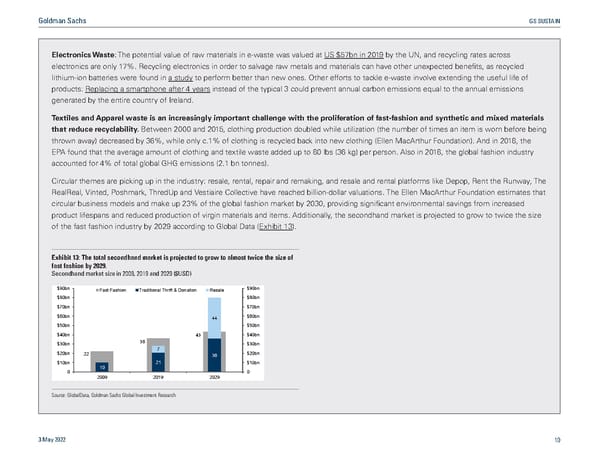Goldman Sachs GS SUSTAIN Electronics by the UN, and recycling rates across Waste: The potential value of raw materials in e-waste was valued at US $57bn in 2019 electronics are only 17%. Recycling electronics in order to salvage raw metals and materials can have other unexpected benefits, as recycled lithium-ion batteries were found in a study to perform better than new ones. Other efforts to tackle e-waste involve extending the useful life of products: Replacing a smartphone after 4 years instead of the typical 3 could prevent annual carbon emissions equal to the annual emissions generated by the entire country of Ireland. Textiles and Apparel waste is an increasingly important challenge with the proliferation of fast-fashion and synthetic and mixed materials that reduce recyclability. Between 2000 and 2015, clothing production doubled while utilization (the number of times an item is worn before being thrown away) decreased by 36%, while only c.1% of clothing is recycled back into new clothing (Ellen MacArthur Foundation). And in 2018, the EPA found that the average amount of clothing and textile waste added up to 80 lbs (36 kg) per person. Also in 2018, the global fashion industry accounted for 4% of total global GHG emissions (2.1 bn tonnes). Circular themes are picking up in the industry: resale, rental, repair and remaking, and resale and rental platforms like Depop, Rent the Runway, The RealReal, Vinted, Poshmark, ThredUp and Vestiaire Collective have reached billion-dollar valuations. The Ellen MacArthur Foundation estimates that circular business models and make up 23% of the global fashion market by 2030, providing significant environmental savings from increased product lifespans and reduced production of virgin materials and items. Additionally, the secondhand market is projected to grow to twice the size of the fast fashion industry by 2029 according to Global Data (Exhibit 13). Exhibit 13: The total secondhand market is projected to grow to almost twice the size of fast fashion by 2029. Secondhand market size in 2009, 2019 and 2029 ($USD) $90bn Fast Fashion Traditional Thrift & Donation Resale $90bn $80bn $80bn $70bn $70bn $60bn 44 $60bn $50bn $50bn $40bn 43 $40bn $30bn 36 $30bn $20bn 7 $20bn 22 36 $10bn 21 $10bn 0 10 0 2009 2019 2029 Source: GlobalData, Goldman Sachs Global Investment Research 3 May 2022 <0
 GS SUSTAIN: Circular Economy Report Page 10 Page 12
GS SUSTAIN: Circular Economy Report Page 10 Page 12